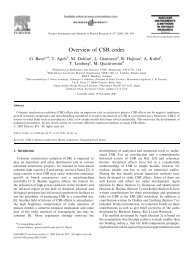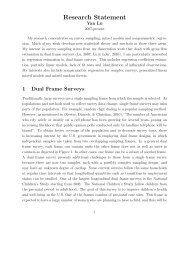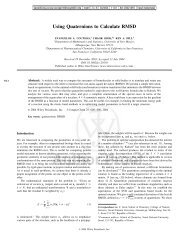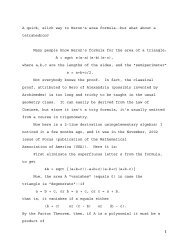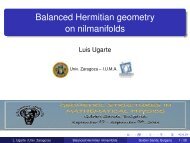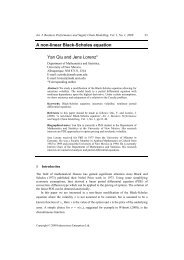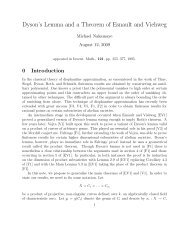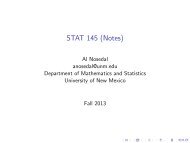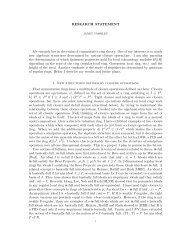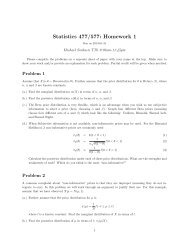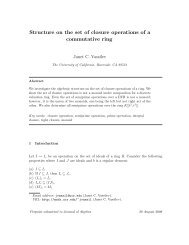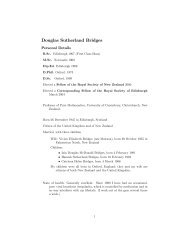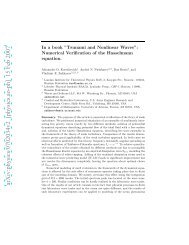OEO Office of Equal Opportunity - Department of Mathematics and ...
OEO Office of Equal Opportunity - Department of Mathematics and ...
OEO Office of Equal Opportunity - Department of Mathematics and ...
Create successful ePaper yourself
Turn your PDF publications into a flip-book with our unique Google optimized e-Paper software.
254 ARTS AND SCIENCES<br />
572./472. Sampling Theory <strong>and</strong> Practice. (3)<br />
Basic methods <strong>of</strong> survey sampling; simple r<strong>and</strong>om sampling,<br />
stratified sampling, cluster sampling, systematic sampling <strong>and</strong><br />
general sampling schemes; estimation based on auxiliary<br />
information; design <strong>of</strong> complex samples <strong>and</strong> case studies.<br />
Prerequisite: 345. {Alternate Falls}<br />
574./474. Biostatistical Methods: Survival Analysis <strong>and</strong><br />
Logistic Regression. (3)<br />
A detailed overview <strong>of</strong> methods commonly used to analyze<br />
medical <strong>and</strong> epidemiological data. Topics include the Kaplan-<br />
Meier estimate <strong>of</strong> the survivor function, models for censored<br />
survival data, the Cox proportional hazards model, methods<br />
for categorical response data including logistic regression<br />
<strong>and</strong> probit analysis, generalized linear models.<br />
Prerequisite: 528 or 540.<br />
576./476. Multivariate Analysis. (3)<br />
Tools for multivariate analysis including multivariate ANOVA,<br />
principal components analysis, discriminant analysis, cluster<br />
analysis, factor analysis, structural equations modeling,<br />
canonical correlations <strong>and</strong> multidimensional scaling.<br />
Prerequisite: 528 or 540. {Offered upon dem<strong>and</strong>}<br />
577./477. Introduction to Bayesian Modeling. (3)<br />
An introduction to Bayesian methodology <strong>and</strong> applications.<br />
Topics covered include: probability review, Bayes’ theorem,<br />
prior elicitation, Markov chain Monte Carlo techniques. The<br />
free s<strong>of</strong>tware programs WinBUGS <strong>and</strong> R will be used for<br />
data analysis.<br />
Prerequisites: 561 <strong>and</strong> (527 or 540). {Alternate Springs}.<br />
579. Selected Topics in Statistics. (3, no limit) ∆<br />
581./481. Introduction to Time Series Analysis. (3)<br />
Introduction to time domain <strong>and</strong> frequency domain models<br />
<strong>of</strong> time series. Data analysis with emphasis on Box-Jenkins<br />
methods. Topics such as multivariate models; linear filters;<br />
linear prediction; forecasting <strong>and</strong> control.<br />
Prerequisite: 561. {Alternate Springs}<br />
582. Advanced Time Series Analysis. (3)<br />
Time series models in the time <strong>and</strong> spectral domains. Linear<br />
filters. Multivariate models. Autoregressive <strong>and</strong> moving average<br />
models. Filtering <strong>and</strong> prediction. Distribution theory.<br />
Design <strong>of</strong> experiments.<br />
Prerequisite: 581. {Alternate Falls}<br />
585. Nonparametric <strong>and</strong> Robust Methods. (3)<br />
Statistical methods that are insensitive to the distribution <strong>of</strong><br />
the data. Sign tests, Kolmogorov-Smirnov tests, rank tests<br />
including the Wilcoxon, Mann-Whitney, Kruskal-Wallis <strong>and</strong><br />
Friedman tests. Robust estimation including M estimators, L<br />
estimators <strong>and</strong> R estimators.<br />
Prerequisite: 561. {Offered upon dem<strong>and</strong>}<br />
586. Nonparametric Curve Estimation <strong>and</strong> Image<br />
Reconstruction. (3)<br />
Nonparametric regression, density estimation, filtering, spectral<br />
density estimation, image reconstruction <strong>and</strong> pattern<br />
recognition. Tools include orthogonal series, kernels, splines,<br />
wavelets <strong>and</strong> neural networks. Applications to medicine,<br />
engineering, biostatistics <strong>and</strong> economics.<br />
Prerequisite: 561. {Offered upon dem<strong>and</strong>}<br />
590. Statistical Computing. (3)<br />
A detailed examination <strong>of</strong> essential statistical computing skills<br />
needed for research <strong>and</strong> industrial work. Students will use<br />
S-Plus, Matlab <strong>and</strong> SAS® to develop algorithms for solving<br />
a variety <strong>of</strong> statistical problems using resampling <strong>and</strong> simulation<br />
techniques such as the bootstrap, Monte Carlo methods<br />
<strong>and</strong> Markov chain methods for approximating probability<br />
distributions. Applications to linear <strong>and</strong> non-linear models<br />
will be stressed.<br />
Prerequisite: 528.<br />
595. Problems. (1-3, no limit) †<br />
597. Statistical Consulting Laboratory. (1-3, no limit) ∆<br />
Provides experience in statistical consulting <strong>and</strong> analysis<br />
<strong>of</strong> real data.<br />
Prerequisite: 528.<br />
599. Master’s Thesis. (1-6)<br />
Offered on a CR/NC basis only.<br />
605. Graduate Colloquium. (1-1 to a maximum <strong>of</strong> 4) ∆<br />
Students present their current research.<br />
649. Seminar in Probability <strong>and</strong> Statistics. (1-3, no<br />
limit) ∆<br />
(Also <strong>of</strong>fered as MATH 649.)<br />
650. Reading <strong>and</strong> Research. (1-6 to a maximum <strong>of</strong> 12) †<br />
699. Dissertation. (3-12)<br />
Offered on a CR/NC basis only.<br />
PEACE STUDIES MINOR<br />
Jennifer Moore, Director (Law)<br />
Betsy Erbaugh, Advisor (Sociology)<br />
Eva Lipton, Finance Coordinator (Medieval Studies)<br />
Sterling Coke, Web Designer (<strong>Mathematics</strong>)<br />
Peace Studies Program<br />
MSC05 3080<br />
SSCI 1103<br />
1 University <strong>of</strong> New Mexico<br />
Albuquerque NM 87131-0001<br />
(505) 277-2501<br />
http://www.unm.edu/~peace<br />
Faculty<br />
Colston Ch<strong>and</strong>ler (Physics)<br />
Philip Gonzales (Sociology)<br />
Alex Lubin (American Studies)<br />
Carole Nagengast (Anthropology)<br />
Shiame Okunor (African American Studies)<br />
Mark Peceny (Political Science)<br />
Christine Rack (Sociology)<br />
Barri S<strong>and</strong>ers (UNM-Taos, Peace Studies Program)<br />
Fiona Sinclair (American Studies)<br />
Jane Slaughter (History)<br />
Students<br />
Desi Brown (BUS)<br />
Angela Kostelnick (Peace Studies)<br />
Community Partners<br />
Anita Amstutz (Albuquerque Mennonite Church)<br />
Introduction<br />
The minor in Peace Studies is an interdepartmental <strong>and</strong> interdisciplinary<br />
program designed to introduce students to the<br />
causes <strong>and</strong> consequences <strong>of</strong> conflict. The program allows<br />
students the opportunity to examine alternatives to violence<br />
<strong>and</strong> to reflect upon the nature <strong>of</strong> peace as a sustainable<br />
condition at the individual <strong>and</strong> collective levels.<br />
In the twenty-first century, the problem <strong>of</strong> violence exists on<br />
multiple levels, from domestic abuse <strong>and</strong> entrenched poverty<br />
to international armed conflict, terrorism <strong>and</strong> counter-terrorism.<br />
We face the prospect <strong>of</strong> a nuclear conflagration on<br />
one side, with the daily reality <strong>of</strong> low-technology conflicts in<br />
dozens <strong>of</strong> countries on another. In the organized violence<br />
<strong>of</strong> warfare, far more civilians die than soldiers; small arms<br />
destroy more than sophisticated weaponry, <strong>and</strong> war-related<br />
poverty, displacement, <strong>and</strong> disease are the biggest killers <strong>of</strong><br />
all. Moreover, in refugee camps <strong>and</strong> urban communities alike,<br />
the pervasive incidence <strong>of</strong> violence within families <strong>and</strong> communities<br />
feeds <strong>and</strong> is fed by violence in its other forms.<br />
Peace Studies students examine the influences that <strong>of</strong>ten<br />
lead to violent conflict, <strong>and</strong> the alternative pathways toward<br />
UNM CATALOG 2006–2007 Symbols, page 611.



